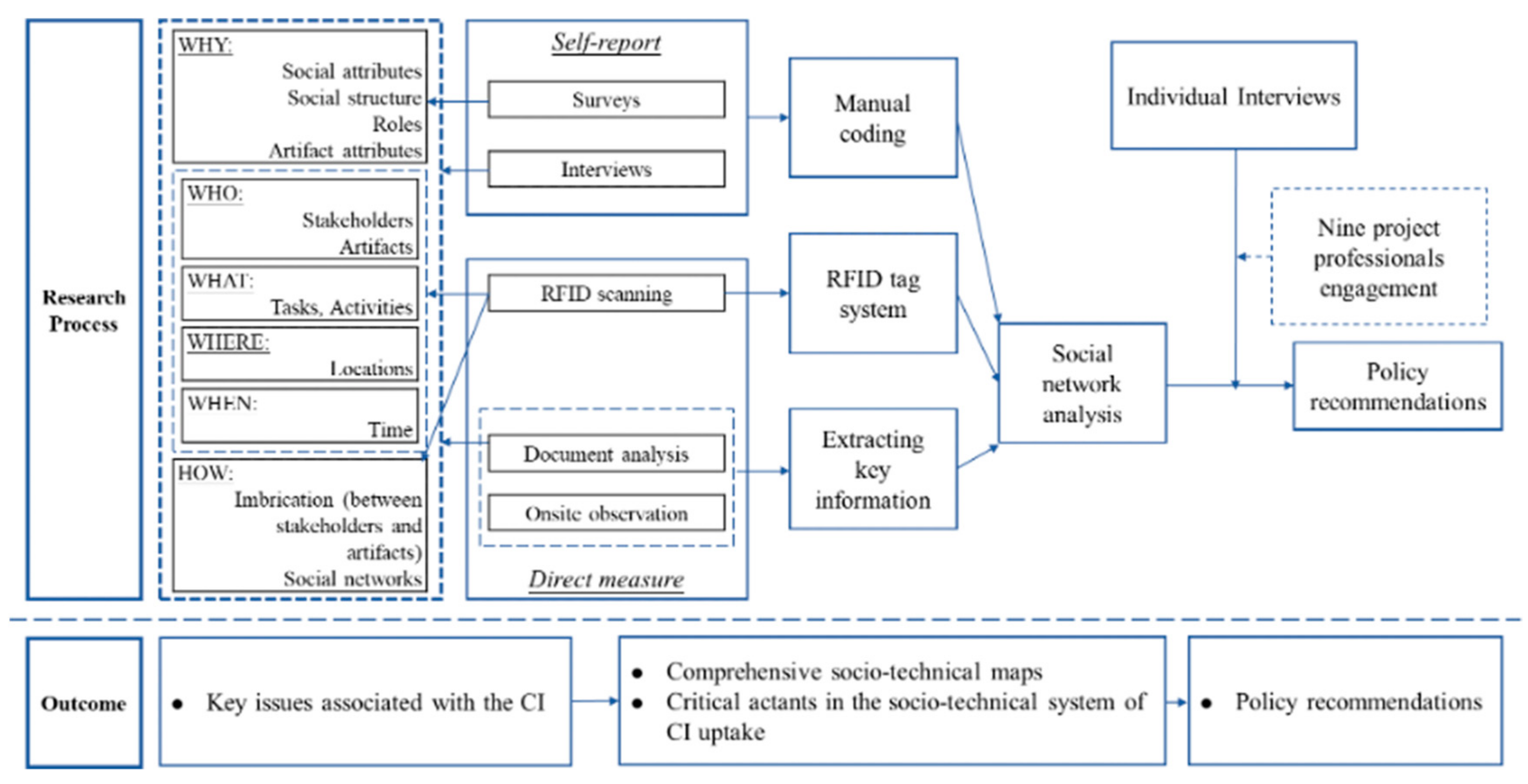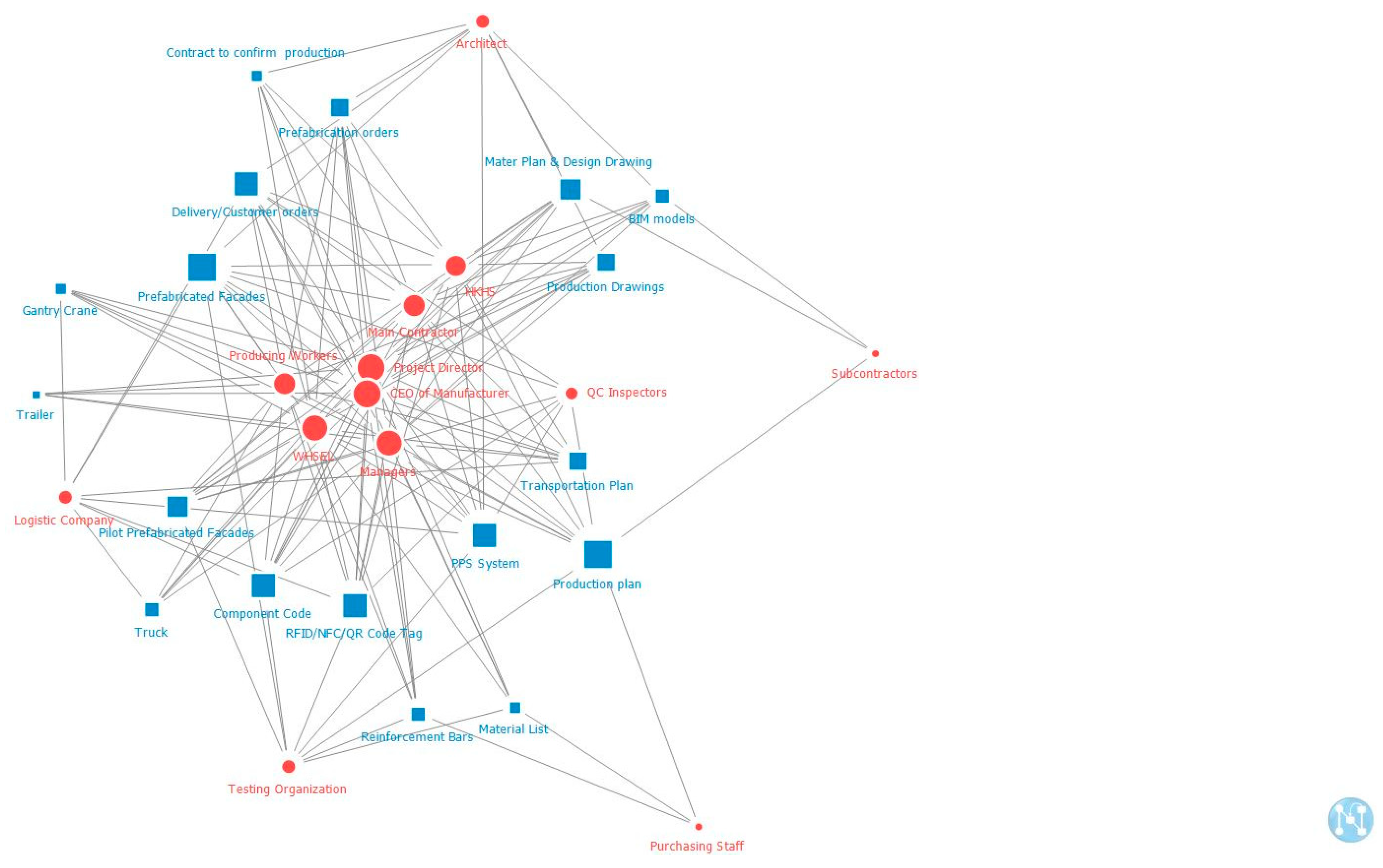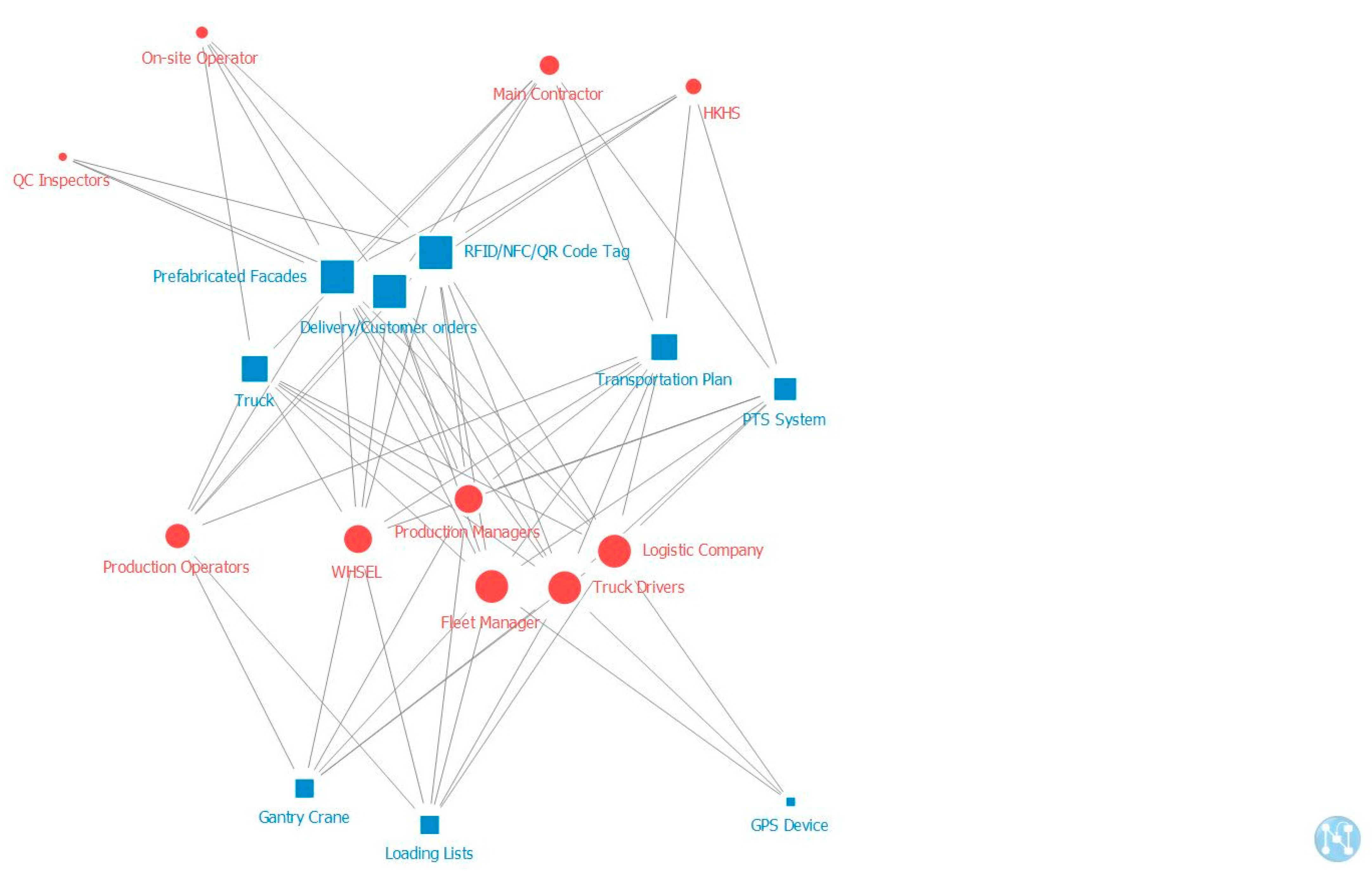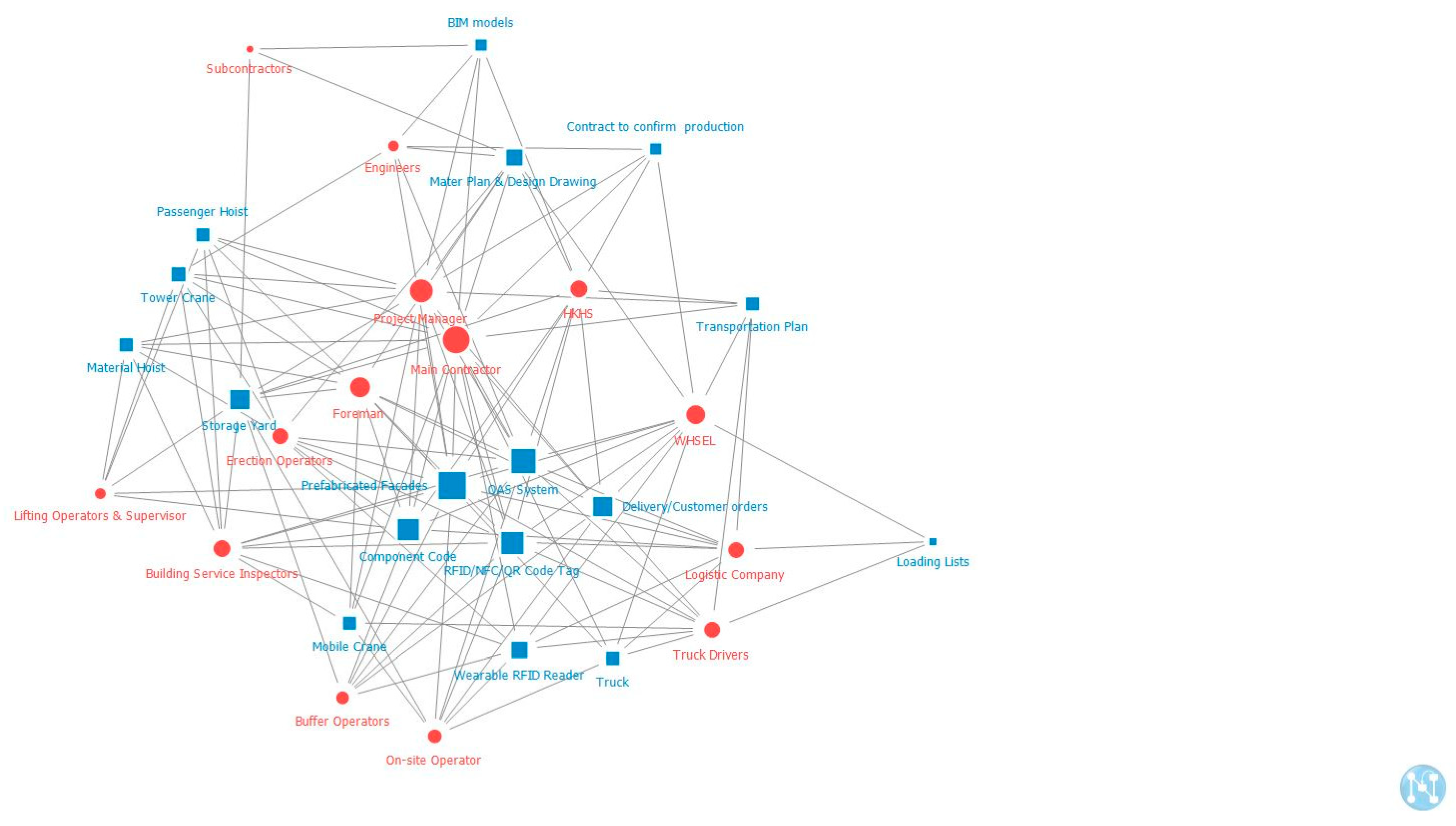Improving Construction Industrialization Practices from a Socio-Technical System Perspective: A Hong Kong Case
Abstract
:1. Introduction
2. Literature Review
2.1. Issues Existing in the Application of CI
2.2. Actants in CI Uptake
2.3. Important Attributes of Actants
3. Research Methods
Case Study Details
4. Results and Discussion
4.1. Comprehensive Maps of the Socio-Technical System of CI Uptake
4.2. Critical Actants in the Socio-Technical System of CI Uptake and Their Dynamic Evolution in the Project Lifecycle
4.3. Key Issues Existing in Hong Kong Regarding the Application of CI
- A.
- Complex cross-border transportation process;
- B.
- Low innovations in prefabrication techniques;
- C.
- High initial cost;
- D.
- Lack of preferential policy;
- E.
- Low standardization;
- F.
- Lack of management practices and experiences;
- G.
- Non-timely communication between the parties.
- A.
- Complex cross-border transportation process
- B.
- Low innovations of prefabrication techniques
- C.
- High initial cost
- D.
- Lack of preferential policy
- E.
- Low standardization
- F.
- Lack of management practice and experience
- G.
- Non-timely communication between the parties
5. Policy Implications and Recommendations
6. Conclusions
Supplementary Materials
Author Contributions
Funding
Institutional Review Board Statement
Informed Consent Statement
Data Availability Statement
Acknowledgments
Conflicts of Interest
References
- Ekanayake, E.; Shen, G.Q.; Kumaraswamy, M.; Owusu, E.K. Critical supply chain vulnerabilities affecting supply chain resilience of industrialized construction in Hong Kong. Eng. Constr. Arch. Manag. 2020. [Google Scholar] [CrossRef]
- Xu, Z.; Zayed, T.; Niu, Y. Comparative analysis of modular construction practices in mainland China, Hong Kong and Singapore. J. Clean. Prod. 2020, 245, 118861. [Google Scholar] [CrossRef]
- Li, L.; Li, Z.; Li, X.; Zhang, S.; Luo, X. A new framework of industrialized construction in China: Towards on-site industrialization. J. Clean. Prod. 2020, 244, 118469. [Google Scholar] [CrossRef]
- Arif, M.; Egbu, C. Making a case for offsite construction in China. Eng. Constr. Arch. Manag. 2010, 17, 536–548. [Google Scholar] [CrossRef]
- Mak, Y.W. Prefabrication and Industrialization of Housing in Hong Kong. Master’s Thesis, The Hong Kong Polytechnic University, Hong Kong, China, 1998. Available online: https://theses.lib.polyu.edu.hk/handle/200/3366 (accessed on 25 August 2021).
- Luo, L.; Shen, G.Q.; Xu, G.; Liu, Y.; Wang, Y. Stakeholder-Associated Supply Chain Risks and Their Interactions in a Prefabricated Building Project in Hong Kong. J. Manag. Eng. 2019, 35, 05018015. [Google Scholar] [CrossRef]
- HKSAR. The Chief Executive’s 2017 Policy Address; HKSAR: Hong Kong, China, 2017. [Google Scholar]
- Seaden, G.; Manseau, A. Public policy and construction innovation. Build. Res. Inf. 2001, 29, 182–196. [Google Scholar] [CrossRef]
- Mao, C.; Shen, Q.; Pan, W.; Ye, K. Major Barriers to Off-Site Construction: The Developer’s Perspective in China. J. Manag. Eng. 2015, 31, 04014043. [Google Scholar] [CrossRef]
- Bijker, W.E.; Hughes, T.P.; Pinch, T.J. The Social Construction of Technological Systems: New Directions in the Sociology and History of Technology; MIT Press: Cambridge, MA, USA, 1987. [Google Scholar]
- Xue, J.; Shen, G.Q.; Yang, R.J.; Zafar, I.; Ekanayake, E.; Lin, X.; Darko, A. Influence of formal and informal stakeholder relationship on megaproject performance: A case of China. Eng. Constr. Arch. Manag. 2020, 27, 1505–1531. [Google Scholar] [CrossRef]
- Geels, F. From sectoral systems of innovation to socio-technical systems: Insights about dynamics and change from sociology and institutional theory. Res. Policy 2004, 33, 897–920. [Google Scholar] [CrossRef]
- Fang, D.; Chen, Y.; Wong, L. Safety Climate in Construction Industry: A Case Study in Hong Kong. J. Constr. Eng. Manag. 2006, 132, 573–584. [Google Scholar] [CrossRef]
- Dalton, T.; Hurley, J.; Gharaie, E.; Wakefield, R.; Horne, R.E. Australian Suburban House Building: Industry Organization, Practices and Constraints; Australian Housing and Urban Research Institute: Melbourne, Australia, 2011. [Google Scholar]
- Schiffer, E.; Hauck, J. Net-map: Collecting social network data and facilitating network learning through participatory influence network mapping. Field Methods 2010, 22, 231–249. [Google Scholar] [CrossRef]
- Meng, X. The effect of relationship management on project performance in construction. Int. J. Proj. Manag. 2012, 30, 188–198. [Google Scholar] [CrossRef]
- Zakaria, T.S.A.S.; Gajendran, T.; Rose, T.; Brewer, G. Contextual, structural and behavioural factors influencing the adoption of industrialised building systems: A review. Archit. Eng. Des. Manag. 2018, 14, 3–26. [Google Scholar]
- Gan, X.; Chang, R.; Wen, T. Overcoming barriers to off-site construction through engaging stakeholders: A two-mode social network analysis. J. Clean. Prod. 2018, 201, 735–747. [Google Scholar] [CrossRef]
- Masood, R.; Lim, J.B.; González, V.A. Performance of the supply chains for New Zealand prefabricated house-building. Sustain. Cities Soc. 2021, 64, 102537. [Google Scholar] [CrossRef]
- Luo, L.Z.; Mao, C.; Shen, L.Y.; Li, Z.D. Risk factors affecting practitioners’ attitudes toward the implementation of an industrialized building system a case study from China. Eng. Constr. Archit. Manag. 2015, 22, 622–643. [Google Scholar] [CrossRef]
- Wang, Y.; Li, H.; Wu, Z. Attitude of the Chinese public toward off-site construction: A text mining study. J. Clean. Prod. 2019, 238, 117926. [Google Scholar] [CrossRef]
- Latour, B. Science in Action: How to Follow Scientists and Engineers through Society; Harvard University Press: Cambridge, MA, USA, 1987. [Google Scholar]
- Freeman, R.E. Two—The Stakeholder Concept and Strategic Management. In Strategic Management: A Stakeholder Approach; Cambridge University Press: Cambridge, UK, 2010; pp. 31–51. [Google Scholar]
- Leonardi, P.M. Materiality, Sociomateriality, and Socio-Technical Systems: What Do These Terms Mean? How Are They Different? Do We Need Them? Mater. Organ. 2012, 25, 24–48. [Google Scholar] [CrossRef]
- Ekbia, H.R. Digital artifacts as quasi-objects: Qualification, mediation, and materiality. J. Am. Soc. Inf. Sci. Technol. 2009, 60, 2554–2566. [Google Scholar] [CrossRef]
- Schmidt, K.; Wagner, I. Ordering systems: Coordinative practices and artifacts in architectural design and planning. Comput. Support. Coop. Work 2004, 13, 349–408. [Google Scholar] [CrossRef]
- Parmaxi, A.; Zaphiris, P.; Ioannou, A. Enacting artifact-based activities for social technologies in language learning using a design-based research approach. Comput. Hum. Behav. 2016, 63, 556–567. [Google Scholar] [CrossRef]
- Mitchell, R.K.; Agle, B.R.; Wood, D.J.; Mitchell, R.K. Toward a Theory of Stakeholder Identification and Salience: Defining the principle of who and what really counts. Acad. Manag. Rev. 1997, 22, 853–886. [Google Scholar] [CrossRef]
- Aaltonen, K.; Jaakko, K.; Tuomas, O. Stakeholder salience in global projects. Int. J. Proj. Manag. 2008, 26, 509–516. [Google Scholar] [CrossRef]
- Aragonés-Beltrán, P.; García-Melón, M.; Montesinos-Valera, J. How to assess stakeholders’ influence in project management? A proposal based on the Analytic Network Process. Int. J. Proj. Manag. 2017, 35, 451–462. [Google Scholar] [CrossRef]
- Lin, X.; Ho, C.M.F.; Shen, G.Q.P. Who should take the responsibility? Stakeholders’ power over social responsibility issues in construction projects. J. Clean. Prod. 2017, 154, 318–329. [Google Scholar] [CrossRef] [Green Version]
- Wood, D.J.; Mitchell, R.K.; Agle, B.R.; Bryan, L.M. Stakeholder identification and salience after 20 years: Progress, problems, and prospects. Bus. Soc. 2021, 60, 196–245. [Google Scholar] [CrossRef]
- Chen, Y.; Okudan, G.E.; Riley, D.R. Decision support for construction method selection in concrete buildings: Prefabrication adoption and optimization. Autom. Constr. 2010, 19, 665–675. [Google Scholar] [CrossRef]
- Safaa, Y.P.; Hatmoko, J.U.D.; Purwanggono, B. Evaluation of the use of prefabricated bridge elements with Design for Manufacture and Assembly (DfMA) criteria. MATEC Web Conf. 2019, 270, 05006. [Google Scholar] [CrossRef]
- Lu, W.; Chen, K.; Xue, F.; Pan, W. Searching for an optimal level of prefabrication in construction: An analytical framework. J. Clean. Prod. 2018, 201, 236–245. [Google Scholar] [CrossRef]
- Gibb, A.G.; Isack, F. Re-engineering through pre-assembly: Client expectations and drivers. Build. Res. Inf. 2003, 31, 146–160. [Google Scholar] [CrossRef] [Green Version]
- Liu, S.; Qian, S. Evaluation of social life-cycle performance of buildings: Theoretical framework and impact assessment approach. J. Clean. Prod. 2019, 213, 792–807. [Google Scholar] [CrossRef]
- Jaillon, L.C.; Poon, C. Design issues of using prefabrication in Hong Kong building construction. Constr. Manag. Econ. 2010, 28, 1025–1042. [Google Scholar] [CrossRef]
- Liang, X.; Shen, G.Q.; Guo, L. Improving Management of Green Retrofits from a Stakeholder Perspective: A Case Study in China. Int. J. Environ. Res. Public Health 2015, 12, 13823–13842. [Google Scholar] [CrossRef] [Green Version]
- Yang, R.J.; Zou, P.X.W. Stakeholder-associated risks and their interactions in complex green building projects: A social network model. Build. Environ. 2014, 73, 208–222. [Google Scholar] [CrossRef]
- Li, C.Z.; Hong, J.; Xue, F.; Shen, G.Q.; Xu, X.; Mok, M.K. Schedule risks in prefabrication housing production in Hong Kong: A social network analysis. J. Clean. Prod. 2016, 134, 482–494. [Google Scholar] [CrossRef] [Green Version]
- Freeman, L.C. Centrality in social networks conceptual clarification. Soc. Netw. 1978, 1, 215–239. [Google Scholar] [CrossRef] [Green Version]
- Meghanathan, N. Graph Tools for Social Network Analysis. In Graph Theoretic Approaches for Analyzing Large-Scale Social Networks; IGI Global: Hershey, PA, USA, 2017; pp. 18–33. [Google Scholar]
- Faust, K. Centrality in affiliation networks. Soc. Netw. 1997, 19, 157–191. [Google Scholar] [CrossRef]
- Borgatti, S.P.; Everett, M.G. Network analysis of 2-mode data. Soc. Netw. 1997, 19, 243–269. [Google Scholar] [CrossRef]
- Yang, R.J.; Zou, P.X.W.; Wang, J. Modelling stakeholder-associated risk networks in green building projects. Int. J. Proj. Manag. 2016, 34, 66–81. [Google Scholar] [CrossRef]
- Yu, T.; Shen, G.Q.; Shi, Q.; Lai, X.; Li, C.Z.; Xu, K. Managing social risks at the housing demolition stage of urban redevelopment projects: A stakeholder-oriented study using social network analysis. Int. J. Proj. Manag. 2017, 35, 925–941. [Google Scholar] [CrossRef]
- Li, C.Z.; Shen, G.Q.; Xu, X.; Xue, F.; Sommer, L.; Luo, L. Schedule risk modeling in prefabrication housing production. J. Clean. Prod. 2017, 153, 692–706. [Google Scholar] [CrossRef]
- Xu, G.; Li, M.; Luo, L.; Chen, C.-H.; Huang, G.Q. Cloud-based fleet management for prefabrication transportation. Enterp. Inf. Syst. 2018, 13, 87–106. [Google Scholar] [CrossRef]
- Li, C.Z. Integrating RFID and BIM technologies for mitigating risks and improving schedule performance of prefabricated house construction. J. Clean. Prod. 2017, 165, 1048–1062. [Google Scholar] [CrossRef]
- Chiang, Y.H.; Chan, E.H.W.; Lok, L.K.-L. Prefabrication and barriers to entry—A case study of public housing and institutional buildings in Hong Kong. Habitat Int. 2006, 30, 482–499. [Google Scholar] [CrossRef]
- Li, C.Z.; Hong, J.; Xue, F.; Shen, Q.; Xu, X.; Luo, L. SWOT analysis and Internet of Things-enabled platform for prefabrication housing production in Hong Kong. Habitat Int. 2016, 57, 74–87. [Google Scholar] [CrossRef]
- Zhou, J.X.; Shen, G.Q.; Yoon, S.H.; Jin, X. Customization of on-site assembly services by integrating the internet of things and BIM technologies in modular integrated construction. Autom. Constr. 2021, 126, 103663. [Google Scholar] [CrossRef]
- Luo, L.; Jin, X.; Shen, G.Q.; Wang, Y.; Liang, X.; Li, X.; Li, C.Z. Supply Chain Management for Prefabricated Building Projects in Hong Kong. J. Manag. Eng. 2020, 36, 05020001. [Google Scholar] [CrossRef]
- Slaughter, E.S. Implementation of construction innovations. Build. Res. Inf. 2000, 28, 2–17. [Google Scholar] [CrossRef]
- Li, L.; Li, Z.; Wu, G.; Li, X. Critical success factors for project planning and control in prefabrication housing production: A China study. Sustainability 2018, 10, 836. [Google Scholar] [CrossRef] [Green Version]
- La Rocca, G.; Van Tooren, M. Enabling distributed multi-disciplinary design of complex products: A knowledge based engineering approach. J. Des. Res. 2007, 5, 333. [Google Scholar] [CrossRef]
- Perkins, I.; Skitmore, M.; Skitmore, R. Three-dimensional printing in the construction industry: A review. Int. J. Constr. Manag. 2015, 15, 1–9. [Google Scholar] [CrossRef] [Green Version]
- Steel, J.; Drogemuller, R.; Toth, B. Model interoperability in building information modelling. Softw. Syst. Model. 2012, 11, 99–109. [Google Scholar] [CrossRef] [Green Version]
- Bamana, F.; Lehoux, N.; Cloutier, C. Simulation of a Construction Project: Assessing Impact of Just-in-Time and Lean Principles. J. Constr. Eng. Manag. 2019, 145, 05019005. [Google Scholar] [CrossRef]
- Jiang, Y.; Zhao, D.; Wang, D.; Xing, Y. Sustainable Performance of Buildings through Modular Prefabrication in the Construction Phase: A Comparative Study. Sustainability 2019, 11, 5658. [Google Scholar] [CrossRef] [Green Version]
- Gao, Y.; Tian, X.-L. Prefabrication policies and the performance of construction industry in China. J. Clean. Prod. 2020, 253, 120042. [Google Scholar] [CrossRef]
- Lee, C.; Baldwin, A.N. Reinventing the Hong Kong Construction Industry for Its Sustainable Development; Construction Industry Institute-Hong Kong: Hong Kong, China, 2008. [Google Scholar]
- Wuni, I.Y.; Shen, G.Q. Barriers to the adoption of modular integrated construction: Systematic review and meta-analysis, integrated conceptual framework, and strategies. J. Clean. Prod. 2020, 249, 119347. [Google Scholar] [CrossRef]
- Jiang, W.; Luo, L.; Wu, Z.; Fei, J.; Antwi-Afari, M.F.; Yu, T. An investigation of the effectiveness of prefabrication incentive policies in China. Sustainability 2019, 11, 5149. [Google Scholar] [CrossRef] [Green Version]
- HKBD. Joint Practice Note No. 1, Green and Innovative Buildings; HKSARG: Hong Kong, China, 2001. [Google Scholar]
- Gan, X.; Chang, R.; Zuo, J.; Wen, T.; Zillante, G. Barriers to the transition towards off-site construction in China: An Interpretive structural modeling approach. J. Clean. Prod. 2018, 197, 8–18. [Google Scholar] [CrossRef]
- Jiang, W.; Huang, Z.; Peng, Y.; Fang, Y.; Cao, Y. Factors affecting prefabricated construction promotion in China: A structural equation modeling approach. PLoS ONE 2020, 15, e0227787. [Google Scholar] [CrossRef] [Green Version]
- Gan, X.L.; Chang, R.D.; Langston, C.; Wen, T. Exploring the interactions among factors impeding the diffusion of prefabricated building technologies: Fuzzy cognitive maps. Eng. Constr. Archit. Manag. 2019, 26, 535–553. [Google Scholar] [CrossRef]
- Building Department. Code of Practice for Precast Concrete Construction; Building Department: Hong Kong, China, 2016. [Google Scholar]
- Si, T.; Li, H.X.; Hosseini, M.R.; Ji, Y.; Liu, C. A Solution to Just-in-Time Delivery for Off-Site Construction: A Conceptual Model. In Proceedings of the Construction Research Congress (CRC) on Construction Research and Innovation to Transform Society, Tempe, AZ, USA, 8–10 March 2020; pp. 345–353. [Google Scholar]
- Jiang, L.; Li, Z.; Li, L.; Gao, Y. Constraints on the Promotion of Prefabricated Construction in China. Sustainability 2018, 10, 2516. [Google Scholar] [CrossRef] [Green Version]
- Xu, X.; Xiao, B.; Li, C.Z. Stakeholders’ power over the impact issues of building energy performance gap: A two-mode social network analysis. J. Clean. Prod. 2021, 289, 125623. [Google Scholar] [CrossRef]
- Li, X.; Chi, H.L.; Wu, P.; Shen, G.Q. Smart work packaging-enabled constraint-free path re-planning for tower crane in prefabricated products assembly process. Adv. Eng. Inform. 2020, 43, 101008. [Google Scholar] [CrossRef]
- Li, X.; Wu, L.; Zhao, R.; Lu, W.; Xue, F. Two-layer Adaptive Blockchain-based Supervision model for off-site modular housing production. Comput. Ind. 2021, 128, 103437. [Google Scholar] [CrossRef]
- Ekanayake, E.M.A.C.; Shen, G.; Kumaraswamy, M.M. Identifying supply chain capabilities of construction firms in industrialized construction. Prod. Plan. Control 2021, 32, 303–321. [Google Scholar] [CrossRef]






| No. | Attributes of Stakeholders | References |
| 1 | Power to influence the project | [28,29,30,31] |
| 2 | Urgency of the stakeholder’s claim on the project | [28,31] |
| 3 | Legitimacy of the stakeholder’s relationship with the project | [28,31] |
| No. | Attributes of the Artifacts | References |
| 1 | Economics | [33,34] |
| 2 | User friendly | [35,36] |
| 3 | Social acceptance | [36,37] |
| 4 | Environmental protection | [34,38] |
| Stakeholders | 2-Mode Normalized Degree Centrality | Artifacts | 2-Mode Normalized Degree Centrality |
|---|---|---|---|
| Production stage | |||
| HKHS | 0.722222 | RFID/NFC/QR Code Tag | 0.769231 |
| WHSEL | 0.944444 | Component Code | 0.769231 |
| Main Contractor | 0.777778 | Truck | 0.538462 |
| Subcontractors | 0.166667 | Trailer | 0.384615 |
| Logistic Company | 0.444444 | Gantry Crane | 0.461538 |
| Producing Workers | 0.777778 | Pilot Prefabricated Facades | 0.692308 |
| Project Director | 1.000000 | Prefabricated Facades | 0.846154 |
| Managers | 0.944444 | Contract to confirm production | 0.461538 |
| Architect | 0.444444 | Mater Plan and Design Drawing | 0.692308 |
| Testing Organization | 0.444444 | BIM models | 0.538462 |
| Purchasing Staff | 0.166667 | Prefabrication orders | 0.615385 |
| CEO of Manufacturer | 1.000000 | Delivery/Customer orders | 0.769231 |
| QC Inspectors | 0.388889 | Transportation Plan | 0.615385 |
| Production plan | 0.846154 | ||
| Production Drawings | 0.615385 | ||
| Material List | 0.461538 | ||
| Reinforcement Bars | 0.538462 | ||
| PPS System | 0.769231 | ||
| Transportation stage | |||
| HKHS | 0.555556 | RFID/NFC/QR Code Tag | 1.000000 |
| WHSEL | 0.888889 | Truck | 0.800000 |
| Main Contractor | 0.666667 | Gantry Crane | 0.600000 |
| Logistic Company | 1.000000 | GPS Device | 0.300000 |
| Truck Drivers | 1.000000 | Prefabricated Facades | 1.000000 |
| Fleet Manager | 1.000000 | Delivery/Customer orders | 1.000000 |
| Production Operators | 0.777778 | Transportation Plan | 0.800000 |
| QC Inspectors | 0.333333 | Loading Lists | 0.600000 |
| Production Managers | 0.888889 | PTS System | 0.700000 |
| On-site Operator | 0.444444 | ||
| On-site assembly stage | |||
| HKHS | 0.588235 | RFID/NFC/QR Code Tag | 0.785714 |
| WHSEL | 0.647059 | Wearable RFID Reader | 0.571429 |
| Main Contractor | 0.941176 | Component Code | 0.714286 |
| Logistic Company | 0.529412 | Truck | 0.428571 |
| Subcontractors | 0.176471 | Tower Crane | 0.500000 |
| Truck Drivers | 0.529412 | Mobile Crane | 0.428571 |
| On-site Operator | 0.470588 | Material Hoist | 0.428571 |
| Erection Operators | 0.529412 | Passenger Hoist | 0.428571 |
| Lifting Operators and Supervisor | 0.352941 | Prefabricated Facades | 0.928571 |
| Buffer Operators | 0.411765 | BIM models | 0.357143 |
| Foreman | 0.705882 | Storage Yard | 0.642857 |
| Building Service Inspectors | 0.588235 | Contract to confirm production | 0.357143 |
| Project Manager | 0.823529 | Master Plan and Design Drawing | 0.571429 |
| Engineers | 0.352941 | Delivery/Customer orders | 0.642857 |
| Transportation Plan | 0.428571 | ||
| Loading Lists | 0.214286 | ||
| OAS System | 0.857143 | ||
| Critical Stakeholders | Critical Artifacts |
|---|---|
| Production stage | |
|
|
| Transportation stage | |
|
|
| On-site assembly stage | |
|
|
| Production | Transportation | Assembly | ||||
|---|---|---|---|---|---|---|
| Stakeholders | Artifacts | Stakeholders | Artifacts | Stakeholders | Artifacts | |
| Most important | Legitimacy | Social acceptance | Legitimacy | Social acceptance | Legitimacy | User friendly |
| Important | Urgency | User friendly | Urgency | User friendly | Urgency Power | Social Acceptance |
| Less important | Power | Economics | Power | Economics | Economics | |
| Least important | Environmental protection | Environmental protection | Environmental protection | |||
Publisher’s Note: MDPI stays neutral with regard to jurisdictional claims in published maps and institutional affiliations. |
© 2021 by the authors. Licensee MDPI, Basel, Switzerland. This article is an open access article distributed under the terms and conditions of the Creative Commons Attribution (CC BY) license (https://creativecommons.org/licenses/by/4.0/).
Share and Cite
Jin, X.; Shen, G.Q.P.; Ekanayake, E.M.A.C. Improving Construction Industrialization Practices from a Socio-Technical System Perspective: A Hong Kong Case. Int. J. Environ. Res. Public Health 2021, 18, 9017. https://doi.org/10.3390/ijerph18179017
Jin X, Shen GQP, Ekanayake EMAC. Improving Construction Industrialization Practices from a Socio-Technical System Perspective: A Hong Kong Case. International Journal of Environmental Research and Public Health. 2021; 18(17):9017. https://doi.org/10.3390/ijerph18179017
Chicago/Turabian StyleJin, Xin, Geoffrey Q. P. Shen, and E. M. A. C. Ekanayake. 2021. "Improving Construction Industrialization Practices from a Socio-Technical System Perspective: A Hong Kong Case" International Journal of Environmental Research and Public Health 18, no. 17: 9017. https://doi.org/10.3390/ijerph18179017






